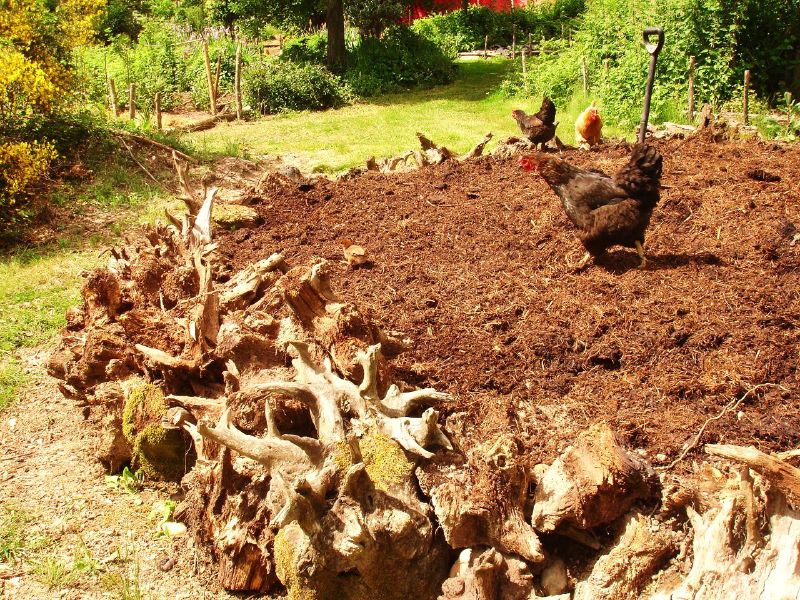Hugelkultur Information: Tips On Using The Hugelkultur System


A hugelkultur system is an excellent way to harvest and recycle any woody materials and organic debris around the garden. This method allows you to clean up any piles in the yard while building soil fertility, improving drainage, and enhancing moisture retention. Hugelkulture garden beds also tend to be warmer than even raised beds for early crop starting. What is a hugelkulture bed? It is a traditional eastern European gardening method that starts out with a pile of logs and branches. Read on for more hugelkulture information.
What is Hugelkulture Bed?
Layered garden beds are nothing new. Lasagna or sheet gardening is an element of landscaping where you flip your sod and layer it with newspaper, cardboard, straw, or other carbon materials and then soil. The resulting layers compost quickly and add tilth and nutrients to the soil. Hugelkultur garden beds have much the same purpose. Instead of sod, however, these rely upon a basis of logs and branches. Then you just tuck in other organic biomass and top with soil and/or straw. The name hugekulture literally means “mound culture.” It is a useful practice on woody land where there is plenty of detritus from fallen trees and branches. In essence, a hugelkulture system is basically buried logs. The logs and branches become spongy as they decompose and soak up massive quantities of water. This means that after a year or so, you hardly have to water a hugelkulture bed at all. The layering of other organic compounds such as kitchen scraps, manure, newspaper, or straw enhances the nutrient composition of the bed. In side by side tests, the hugelkulture bed produced more and larger vegetable plants than a traditional raised bed. This is due to the water storing abilities of the log dome and the rich nutrients and higher heat of the soil.
Hugelkulture Information and How To
The first step in building the log dome is to cut out a 1 foot (31 cm.) deep trench. The size isn’t important, but keep in mind the amount of material you will have to fill a hill of soil at least 3 feet (1 m.) high. Even steeper beds are recommended, as they have more surface area for planting, reduce compaction over time, and make harvesting easier. The second step and the most crucial bit of hugelkulture information is the addition of the logs. Place these in a foot (31 cm.) high pile. Thoroughly moisten the logs. Next, add flipped over turf, seaweed, grass clippings, manure, straw, leaves, or mulch. This should be piled 4 to 6 inches (10-15 cm.) over the logs. Then top with compost or soil, packing it into any large cracks as you work. Water the bed and you are done.
Urban Hugelkulture
In urban settings, it is a bit harder to imagine a large dome of composting material in your front lawn. However, you can plant quite quickly in the dome and as a landscape feature it can function as a berm. Urban hugelkulture offers the ability to add vertical dimension to the landscape that is also productive and interesting. If you happen to have a tree removed, save the logs and make yourself a hugelkulture bed. To start on sod, simply cut down one foot (31 cm.) and set it aside. Once you have layered the dome, use the sod, flipped over, to fill in any major holes. After the first year, the soil will warm up quickly and watering will be reduced to just every few weeks. You can plant directly into a new bed or plant a cover crop, like red clover, in order to enhance nitrogen and tilth.
Gardening tips, videos, info and more delivered right to your inbox!
Sign up for the Gardening Know How newsletter today and receive a free copy of our e-book "How to Grow Delicious Tomatoes".

Bonnie Grant is a professional landscaper with a Certification in Urban Gardening. She has been gardening and writing for 15 years. A former professional chef, she has a passion for edible landscaping.
-
 Creative Ideas For Plant Containers: 7 Ways To Save Money And Add Charm To A Garden
Creative Ideas For Plant Containers: 7 Ways To Save Money And Add Charm To A GardenIf you are looking for great ways to add personality to your container gardening – and even save yourself some money – then try these creative ideas for plant containers
By Mary Ellen Ellis
-
 How To Make A Bouquet Garni Or Herb Bundle For Cooking
How To Make A Bouquet Garni Or Herb Bundle For CookingIf you’re a great cook, you may have made an herb bundle before. If this is a new idea, learn how to add sparkle and interest to your dish with a bouquet garni.
By Amy Grant